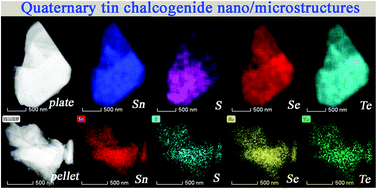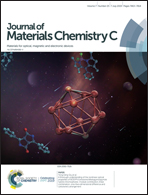Anion-exchange synthesis of thermoelectric layered SnS0.1Se0.9−xTex nano/microstructures in aqueous solution: complexity and carrier concentration†
Abstract
Nanostructured SnS0.1Se0.9−xTex (x = 0.02, 0.05, 0.08) quaternary chalcogenides have been controllably synthesised via a facile solution-processable anion-exchange method. All the products exist as “flower-like” architectures assembled from individual nano/microplates that are each hundreds of nanometers in thickness and several micrometers in lateral size. This morphology is essentially preserved from the original SnS starting material. Spark plasma sintering (SPS) not only consolidates the as-prepared powder samples, but also eliminates secondary phases, leading to pellets of phase-pure SnS0.1Se0.9−xTex solid solution members. The electrical conductivity of SnS0.1Se0.88Te0.02 is significantly enhanced over the Te-free material in the low-temperature range, achieving a peak value of ≈5760 S m−1 at 373 K, which is ≈41% higher than SnS0.1Se0.9 at the same temperature. Also possessing a high Seebeck coefficient, SnS0.1Se0.88Te0.02 exhibits a maximum power factor (ca. 0.54 mW m−1 K−2) at 423 K. The thermoelectric performance of SnS0.1Se0.9−xTex has been optimised through modifying the Te concentration, leading to a peak ZT of ≈0.43 for SnS0.1Se0.88Te0.02 at 773 K. This robust, scalable and surfactant-free approach paves the way to engineer increasingly complex (in this case, quaternary) metal chalcogenides controllably in aqueous solution.



 Please wait while we load your content...
Please wait while we load your content...